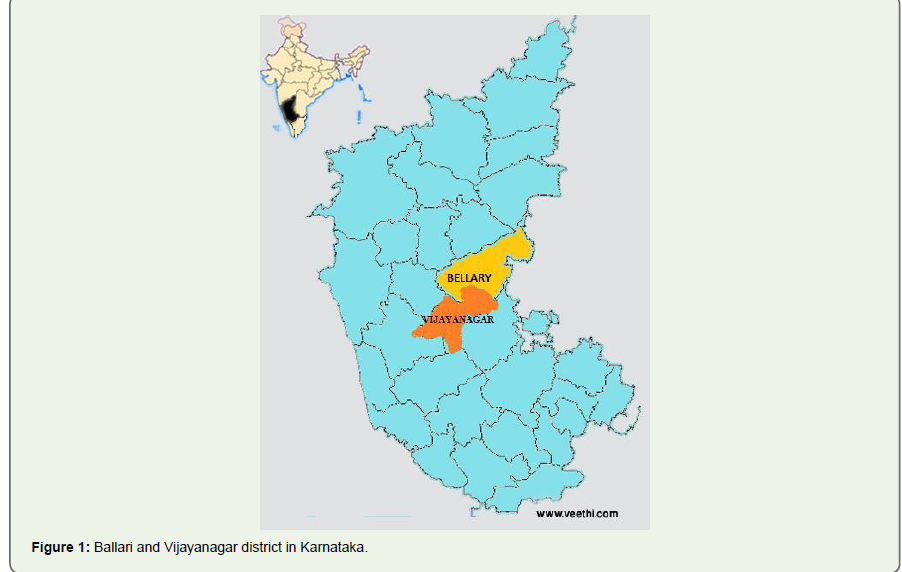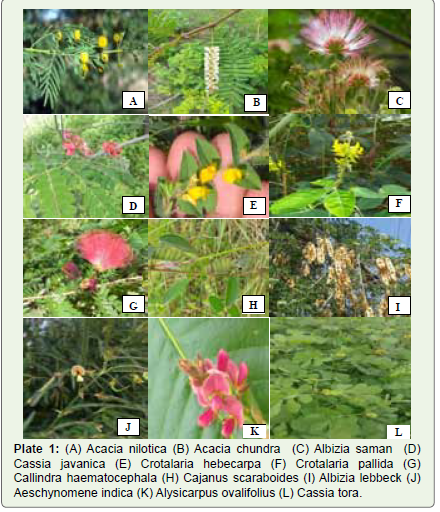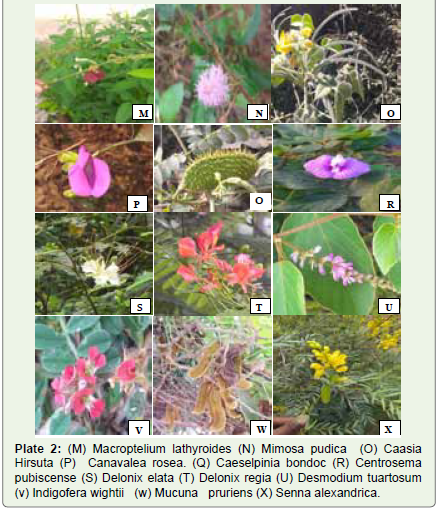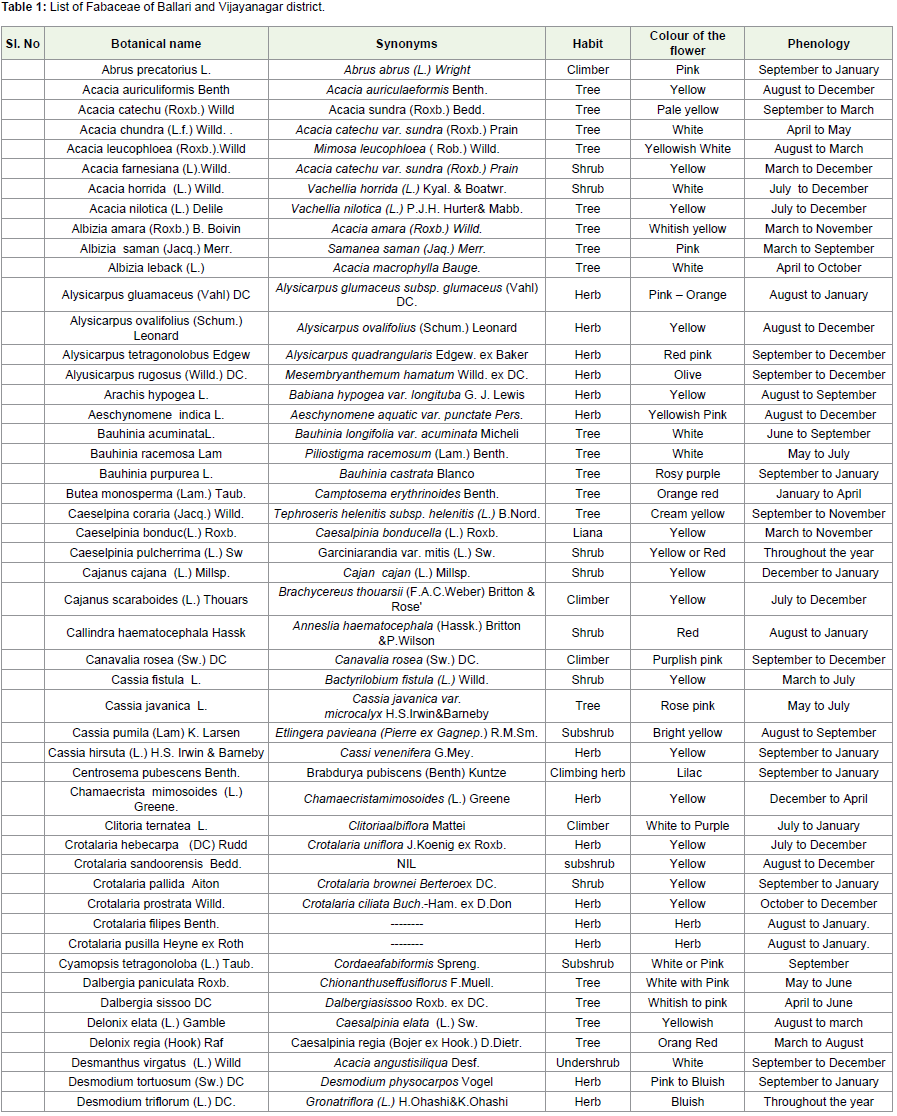Research Article
Diversity of Fabaceae Species in Ballari and Vijayanagar District
Kavitha Sagar* and Sharanabasav Amarappa
Department of P.G. Studies & Research in Botany, Vijayanagara Sri Krishnadevaraya University, Ballari, India
*Corresponding author: Kavitha Sagar, Department of P.G. Studies & Research in Botany, Vijayanagara Sri Krishnadevaraya University, Ballari, India. E-mail Id: drkamsgg@gmail.com
Copyright: © Sagar K, et al. 2023. This is an open access article distributed under the Creative Commons Attribution License,which permits unrestricted use, distribution, and reproduction in any medium, provided the original work is properly cited.
Article Information: Submission: 13/04/2023; Accepted: 15/06/2023; Published: 20/06/2023
Abstract
Fabaceae is one of the largest orders of flowering plants. This order is distributed worldwide and exhibits the greatest diversity of morphological types in tropical and subtropical regions of the world. Fabaceae comprises the major families such as Caesalpiniaceae, Mimosaceae and Papilionaceae. To explore the diversity of this family in Ballari District, regular field visits were made. This is one of the large agriculturally important family. It includes trees, shrubs, and herbs. This family containing ornamental, dye yielding, gum yielding and medicinal plants. Present study enumerated the Family Fabaceae with total 58genera, 122 species largest family Fabaceae covered most of the diversity. Of which 41.33% species are herb, 12.95% species are shrub and subshrub & climbing s herb 0.81% and 31.96% are trees each .The study was documented with flowering and fruiting seasons and distribution in the Ballari and
Vijayanagar localities.
Keywords: Acacia; Senna; Indigofera; Fabaceae
Introduction
Plant diversity is the sum of diversity of life on the earth. It
contains all types of population and ecosystems. The studies of
biodiversity have greater significance as ecologist and taxonomist try
seriously to document the global biodiversity. It is essential to prepare
districts floras where there is severe threat to natural vegetation due to
identification of species that are in different stages of vulnerability as
well as the various factors that influence the existing vegetation in any
region [1]. The Fabaceae or Leguminosae, commonly known as the
legume, pea, or bean family, are a large and economically important
family of flowering plants. The group is the third- largest land plant
family, behind only the Orchidaceae and Asteraceae, with 730 genera
and over 19,400 species [2]. Papilionaceae family are herbs, shrubs or
trees. Mostly it is found between and near the tropics. These are found
large quantity in the old than in the new world. It is important for
yield nutritious food, fiber, shelter and valuable medicines and also
important for virulent poison (Sharma M. and Kumar A. 2013) [3].
Fabaceae family plants are reported for their good medicinal values
in various plant parts such as leaf, stem, bark and roots and native of
these plants, in India, (Ramrakhiyani C. et al., (2016). A number of
these plants have great importance in medicinal purposes and also
used to produce a large range of natural products including flavors,
dyes, poison [4]. Leguminous plants play a vital role in this spheres
being the chief suppliers of the vegetable protein to the predominantly
vegetarian population of India. Legumes are grown agriculturally,
primarily for their grain seed called pulses, which fulfills food desires
as a nutrients to humans. Plants of this family are found throughout
the world, growing in many different environments and climates. A
number are important agricultural and food plants.
Study Area
Ballari and Vijayanagara are the districts of the Karnataka state in
India and located in Kalyana Karnataka region. The district Ballari is
located at north east part of the Karnataka, with five talukasi.e Ballari,
Kampli, Sanduru, Sirguppa, and Kurugodu. The district covers with
8447 Sq. Kms. with forests and non forest areas. The district is mainly
covered by scrub-thorny and dry deciduous forests.
Plate 1: (A) Acacia nilotica (B) Acacia chundra (C) Albizia saman (D)
Cassia javanica (E) Crotalaria hebecarpa (F) Crotalaria pallida (G)
Callindra haematocephala (H) Cajanus scaraboides (I) Albizia lebbeck (J)
Aeschynomene indica (K) Alysicarpus ovalifolius (L) Cassia tora.
Plate 2: (M) Macroptelium lathyroides (N) Mimosa pudica (O) Caasia
Hirsuta (P) Canavalea rosea. (Q) Caeselpinia bondoc (R) Centrosema
pubiscense (S) Delonix elata (T) Delonix regia (U) Desmodium tuartosum
(v) Indigofera wightii (w) Mucuna pruriens (X) Senna alexandrica.
The district Vijayanagara is located in the state Karnataka, this
district was carved out Ballari district officially on 2 October 2021
to become a district, with six talukas i.e. Hosapete, Harapanahalli,
Kudligi, Hoovina Hadagali, Hagaribommanahalli and Kotturu. The
district is covered by 4252 square kilometers with forest and non
forest areas. The district is mainly covered by scrub-thorny and dry
deciduous forest.
Materials and Methods
The intensive qualitative field surveys were conducted throughout
Ballari and Vijayanagara districts from 2020 to 2022. All the plants
growing naturally in various habitats including Wild and cultivated
plants were also documented. The collected plant species were
identified by using national floras [5,6], state floras [7,8], local and district floras [9-11], books [12], recent literatures and check lists. The collected specimens were photographed, pressed, dried and prepared
herbarium followed by standard method of Rao and Jain (1977) . The
prepared Herbarium specimens were deposited at Mahatma Gandhi
Botanical Garden, GKVK, UAS, Bengaluru.
Results and Discussion
The intensive qualitative field survey of species of the family
Fabaceae of Ballari and Vijayanagara Districts shows 122 species
under 58 genera with different Habit. Of which Senna was dominant
genera with 11 species; followed by Acacia with 7 species, Crotalaria
6 species; Indigofera with 8 species, Vigna 5 species, Cassia 4
species, Alysicarpus 4 species, Dalbergia 3 species, Desmodium 3
species, Tephrosia 3 species, Albizia 3 species Rhynchosia 3 species
Sesbania 2 species Zornia 2 species,Cajanus 2 species, Abrus, Aralia,
Butea, Callindra, Canavalia, Clitoria, Chamaecrista, Desmanthus,
Dichrostachys, Erythrina, Gliricidia, Hardwikia, Macroptelium,
Leucaena, Meliolotus, Melletia, Mucuna, Mundolea, Paracalyx,
Parkia, Parkinsonia, Phaseolus, Piliostigma, Pisum, Pongamia,
Psorelia, Pterolobium, Saraca, Stylosanthus, Tamarindus, Taverniera,
Vauchelia, and other having 1 species. The catalogue of plant species
along with the Botanical name, synonyms, habit, colour of the
flower, phenology, in the table – 1. Based on life form classification
the collected species show more dominant with Herbs (41 species
33.60%), followed by Shrubs (13 Species, 10.65%), Subshrubs (03
Species, 2.45%), Climber (12 Species, 9.83%) Climbing herb (1
species, 0.81%) Lianas (03 species, 2.45%) Under Shrubs (03 Species,
2.45%) Trees (39 Species, 31.96%).
Conclusion
In the present investigation, total 122 species and 58 genera of
Fabaceae were recorded from Ballari &Vijayanagara districts. Of
which 41.33% species are herb, 12.95% species are shrub and subshrub
& climbing s herb 0.81% and 31.96% are trees each . Flowers of
most of the species are yellow coloured which draws the attention
of all. Most of the collected species have been used as medicines in
traditional medicine practices in India especially Ayurveda, Unani
and Siddha. Caeselpinia pulcherrima, Cajanus cajana, Cassia
javanica, Crotalaria pallida, Desmodium triflorum, Gliricidium
sepium, Indigofera cordifolia, Mimosa pudica, Mucuna pruriens,
Macroptelium lathyroides, Tamarindus indica, Vigna radiata, Vigna
aconitifolia, Tephrosia purpurea etc. have mentioned in many research papers regarding ethnobotanical studies from various parts
of India. Most of the plants are aromatic plants in flowers. Few species
are grown as ornamental plants, Parkinsonia aculata, Caeselpinia
pulcherrima, Acacia auriculiformis, Mimosa pudica, Delonix regia,
Delonix elata, Senna spp. Callindra haematocephala etc. Indigofera
cordifolia, Macroptelium lathyroides, Rothia indica , Alysicarpus
glumaceus, Alysicarpus tetragonolobus, Rhynchosia minima and
Rhynchosia suaveolens etc are reported as weeds of cultivated lands,
gardens, and disturbed lands. The present investigation is an effort to
document the Fabaceae of Ballari and Vijayanagara Districts where
most it is observed that majority of the species are found as natural
vegetation and may prove to be potential candidates for exploration
of antibacterial, antihelmentic, anti-inflammatory, anticancer , would
healing properties. Many plant species mentioned above which have
bright coloured inflorescence can be cultivated as ornamentals.
Acknowledgements
We thank, Mahatma Ghandhi Botanical Garden, Herbarium
centre Bangalore, Botanical Surveyof India, Coimbatore, and Pune
for permitting to refer the herbarium and library.
References
12. Kavitha S, Rajanna MD (2015) A Handbook on weeds of Karnataka. Centre for plant taxonomic studies.




